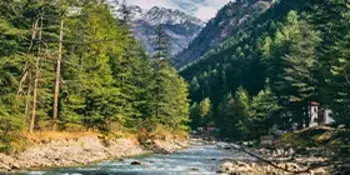

Tosh’s roots lie deep in the folds of Himachal’s pastoral culture. Traditionally a village of shepherds and farmers, Tosh was isolated for generations, accessible only by foot. With time, as the backpacking culture spread through Parvati Valley, Tosh became known among trekkers seeking solitude. It was never a touristy village — and that’s what kept its charm intact. Its wooden homes, slate rooftops, and apple orchards tell tales of quiet resilience and simple living, passed down through generations. Even today, many locals follow age-old traditions — celebrating seasonal festivals, praying at ancient temples, and living with deep respect for nature.

Places To Visit In Kasol
Top places to visit in Kasol, naturally serene.
.webp)
Images Of Kasol
Kasol Photo Gallery: Explore the Beauty of Parvati Valley
Places To Visit In Kasol
Images Of Kasol
Last motorable stop is Barshaini, from where you hike 3–4 km uphill to Tosh.
Power cuts and patchy Wi-Fi are common. Tosh is more about disconnecting than staying online.
Budget stays & cafés are plenty, but luxury is minimal — think cozy wooden rooms with mountain views.
Weather changes fast — always carry layers, even in summer.
Respect local culture — while cannabis grows wild and is known in Tosh, it’s still illegal.
Eco-consciousness matters — carry reusable water bottles, avoid plastic, and leave no trace.
Best Time to Visit Tosh: Peak Season: April to June Mid Season: September to November Off Season July–August
Tosh’s roots lie deep in the folds of Himachal’s pastoral culture. Traditionally a village of shepherds and farmers, Tosh was isolated for generations, accessible only by foot. With time, as the backpacking culture spread through Parvati Valley, Tosh became known among trekkers seeking solitude. It was never a touristy village — and that’s what kept its charm intact. Its wooden homes, slate rooftops, and apple orchards tell tales of quiet resilience and simple living, passed down through generations. Even today, many locals follow age-old traditions — celebrating seasonal festivals, praying at ancient temples, and living with deep respect for nature.
The most pleasant time to explore Tosh is April to June — spring brings wildflowers, snow melts into clear streams, and the days are sunny with cool breezes. September to early November is another ideal window, with post-monsoon freshness, clearer skies, and crisp autumn air. Winters (late November to February) turn Tosh into a snow globe — magical, yes, but very cold and less accessible. July and August bring rains, which can make trekking routes slippery and uncertain, though the valley becomes wildly lush and green.
Altitude: Tosh is located at about 7,874 feet (2,400 meters) above sea level, offering breathtaking mountain views.
Location: It’s nestled in the Parvati Valley of Kullu district, about 20 km from Kasol.
Access: The nearest roadhead is Barshaini, from where you must trek 3-4 km uphill to reach Tosh.
Population: A small village with a few hundred residents, mainly involved in farming and tourism.
Culture: Tosh has a mix of Himachali and Tibetan influences, reflected in its festivals, food, and architecture.
Climate: Summers are mild and pleasant; winters bring heavy snowfall that often isolates the village.
Nature: Surrounded by dense pine forests, apple orchards, and mountain streams, making it a paradise for nature lovers.
Connectivity: Limited electricity and patchy mobile networks make it a peaceful digital detox spot.
Tourism: Gained popularity recently as a quieter, less commercial alternative to Kasol, attracting trekkers, backpackers, and artists.
Unique: Known for its laid-back vibe, organic food cafés, and beautiful trails leading to places like Kheerganga.
Locals speak of glowing lights in the forest, unexplainable sounds in the mountains, and old spirits guarding the valley. One popular tale is about a wandering sage who meditated near Tosh and left behind healing energies — which some say can still be felt on solitary walks through its trails. There are whispers of Tosh being a “watchpoint” for Himalayan gods. Around bonfires, old villagers share stories of fairies, mythical snow leopards, and times when snow once cut them off from the world for weeks. Whether you believe in folklore or not, Tosh makes you feel something spiritual.
A valley is a low-lying area between hills or mountains, often formed by the erosion of water or glaciers. Valleys are characterized by their U-shaped or V-shaped profiles and can contain rivers, streams, and fertile land.